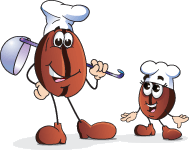|
One of the lovely, deserted beaches along the North coast: the Caribbean sea, warm and inviting. Late in the year ( October/November ) and the temperature of the water was around 84F WARM or what!!! Unfortunately, all this warm water is where the storms and hurricanes "feed" from: last year, with only a few , late storms in the Caribbean, the water was much warmer than usual ( a big storm will extract a lot of heat from the waters, and what it leaves, gets well mixed up with the cooler water, below the surface ). Then, just after writing that, we get 2 late hurricanes, which did a fair bit of damage, to the Island: BUT: there is always a "silver lining", and in this case, an article in the Gleaner with some recipes to use the semi-mature bananas from the blown down, trees:- Cheesy bananas: 2 dozen green bananas ( might seem a lot, but green bananas are smaller, and have a higher proportion of "skin" on them, far less sweet, and a much less pronounced, banana flavour ) peeled and then boiled in salted water, until soft: mash them up, with a little milk. Saute some sliced carrots, in oil, add a little water, and then boil until cooked. Beat 2 large eggs, add the cooked carrots, seasoning, a chopped stalk of celery, 8 ounces of grated cheese, and a large, finely chopped onion. Then ( just like making a Lasagne ) fill a baking dish with alternate layers of the mashed bananas, and the cheese sauce: bake for 15-20 minutes at 350F. Have not yet tried this recipe, but I think it would benefit from, a little garlic, and some mixed herbs, in the cheese mixture. If the bananas are still green, but full sized, they will ripen in a few days, if kept somewhere, cool, dry and dark. Banana Chiffionade: mash up 4 ripe bananas, with 4 tablespoons of honey, 24 ounces of milk, half a teaspoon of Vanilla, and the same of Almond, essences; and mix to a fairly smooth texture: deep chill, and serve with a topping of grated nutmeg. This will also freeze, for later use. Now: to my palate, this is far too sweet!! I would suggest using no more than half ( or less ) the amount of honey, and add some double cream, or, lemon juice: whipping the mixture in a blender, and chilling, before stirring in the mashed bananas. Many years ago, my late Father ( a professional Chef ) got hold of a large box of over-ripe bananas, that were turning black on the outsides ( which was when we discovered that our family dogs, enjoy the odd banana!! ) He skinned them all, threw away the black bits, and whipped up the rest, in a food processor, with some very cheap vanilla ice cream, and made some excellent banana ice cream: the rest he just froze, and used in all sorts of "sweet", pudding, recipes, and an excellent addition to the Christmas fruit cake! Raspberries, and Mulberries, with their high acid content, just mashed with a fork, and a little unsweetened, cream, make a superb sauce to pour over the banana ice cream.
It is one of those very strange things, I have yet to find a decent coffee shop, in Kingston: in fact, the only one I have found, is halfway up the mountain, between Kingston and home: they do an excellent cup of JBM, but very expensive!! Jamaicans are not big coffee drinkers, much preferring overly sweet "soda" drinks,. All the "famous" soda drinks, like Coke and Pepsi; are made in Jamaica, but with a lot more sugar added, and are distinctly sweeter than their counterparts, in other Countries. Recently there were several letters in the Gleaner, concerning our "national dish": Achee and saltfish: the saltfish is imported, salted cod, from Norway!! hardly a local ingredient! Achee is a most unusual fruit; pear sized fruits, borne on big trees: when ripe they are yellow to red in colour: and split into 3 segments, each segment containing a ( smooth, black ) walnut sized seed, surrounded by a yellow "pith": and it is the "pith" that is edible. When cooked it is remarkable similar to scrambled eggs, both in flavour and texture! If the Achees are not fully ripe, they are poisonous, and, apparently, Jamaica is one of the few Countries, where they grow, that actually eats them! The general consensus of opinions, was to change our national dish, to something purely, Jamaican, and jerk pork, was the favoured choice. There is little in the way of "documentary evidence" ( = old recipe books ) as to how the modern Jamaican style of food, developed; but I think one can do a bit of "reverse thinking" and get some ideas as to its development. When Jamaica first became an British colony, the most profitable crop, was sugar; and thousands of slaves were imported from all over Africa, to work the plantations ( a shameful part of world history, but it now is just that: "history" ). The plantation owners made huge fortunes, and imported European chefs, to add to the English cooks, and the household "kitchen slaves": inevitably the cooking styles, started to get intermixed: the European chefs, making use of the local ingredients, adapting their style of cooking to make the best use of them. Two distinct styles of cooking emerge: the "Massa's" table, and the slaves "stewpot" ( using all the left-overs from the "big house", as without refrigeration, food very quickly goes "off" ) mixed in with the cheapest of available food, that the "Massa's" provided for them; inevitably the slaves seek any dietary additives that they can find in the "jungles" around the plantations. The evidence for this style of "stewpot" cooking, still abounds around Jamaica: many places serving "soup", in many traditional recipes: hardly what I would call "soup", being more akin to a thick "stew", with loads of bits of meat, and vegetables, in it. Bones form a big part of making a "stew pot", it is more than just their flavour addition to the stew, but most Jamaicans that I have eaten with, consider that one of the high-lights of the meal, is the noisy, sucking of the bones!! There is also a long tradition of using many sorts of local "herbs", for their medicinal properties: a tradition which probably derived from the slaves lack of any other source of medical treatment: and if the traditions are to be believed, in many cases, these herbal remedies were superior to the best of the "modern" doctoring methods used at the time, by European doctors. And in some cases, superior to modern "western style" medical treatments!
As Jamaica became more "civilised", and the economy grew, through the 17th and 18th centuries, many peoples arrived on these idyllic shores, seeking their fortunes; and amongst them were the Chinese, who had a great impact on the local cuisine, establishing rice as one of the staples in the diet, and developing their own "style" of sauces, made with the locally available ingredients: and today the Jamaican style of the Chinese "sweet and sour" sauce, is a great favourite, and found in most of the roadside cook-shops ( which can vary from, wood or concrete buildings, to a road side tarpaulin stretched over a wood frame; several old car wheels, with charcoal fires in them, and huge pots of hot food ): a plastic food container, with a good portion of rice, and either sweet and sour, pork or chicken, a bottle of drink, and all for around ?2 or US$3. As far as I have been able to find, the Indian style of curry, is more or less confined to the "special occasion" cooking of a party-sized, pot of Curried Goat ( and it is Excellent!! but as most of the local goat meat, is very tough, it needs a long cooking time, and is not a dish that one would cook for just a couple of people, but perfect for a full-sized, bashment ( = party, in the local speek! ).
Jamaican style goat curry:- Fry the curry powder in hot ( coconut ) oil; and add: chopped onion, garlic, scallion, pepper, thyme, ginger, salt ( just a little, if more is needed, add towards the end of the cooking ) stir up well, and add the meat, cover with water DO NOT STIR: ( apparently this is an essential part of the recipe ) leave for 20 minutes and then stir in to the simmering pot: parsley, finely chopped celery. oregano, rosemary, sage, and leave to simmer. Checking occasionally, to ensure there is always sufficient water/sauce, to cover all the meat. A bit of guess-work and testing, needed here: the goat meat can take between 1 and 4 hours to cook, depending on the age of the goat that supplied the meat: about 45 minutes before serving, add some potatoes, green (sweet ) peppers, and turnips, chopped into about 1/2inch cubes, and cook them in the sauce: check the salt in the sauce, and add more if required ( the potatoes will absorb some of the salt previously added ). The finished curry should have a lot of liquid sauce, with it: and be seriously hot on the tongue: a couple of bottles of ice-cold Red Stripe, being the perfect "cooler" for the palate. Accompaniments:- Savoury rice, plain white rice: rinsed thoroughly ( to remove all the loose starch ) and cooked in, a carefully measured, 2.5 times the volume of water, add salt and boil. adding:- chopped scallion and thyme, onion, a whole scotch bonnet pepper ( must be whole, and green ), along with some herbs and spices, crushed Pimento, ginger, and pepper: a little turmeric will give the rice a nice saffron-yellow colour. The rice should cook-out dry, with no excess water to drain off. Vegetables: into a large pot of boiling, salted water; put green bananas, peeled and sliced yam, peeled and chopped sweet potatoes, ( along with any other vegetables, that are available ) and dumplings ( flour, water, salt and pepper, mixed to a stiff dough, and shaped into discs, just under 1/2 inch thick, and then squeeze the centre to half that thickness, dust with a little more flour, and drop into the boiling, salted water ). When all the vegetables are cooked, drain off the water, and turn out into a large bowl, pour just a little of the sauce from the curry pot, over them, sprinkle with parsley ( or any other finely chopped green herb ) and serve. No matter how hot the curry tastes, it ( along with almost every other plate of food served in Jamaica ) must be served up with a bottle of very hot pepper sauce, along with the salt and pepper, on the table. For some reason, Jamaicans don't eat any form of bread, with their goat curry, but unleavened breads form an integral part of Indian cookery: there is the "Trin-Jam" roti ( a combined recipe from Trinidad, and Jamaica ) unleavened bread ( flour, water, salt and pepper, a touch of coconut oil: mixed to a stiff dough, left to prove for 20 minutes, and rolled very thin: half covered with cooked chick peas, folded over, the edges sealed with a little water, and cooked on a hot metal plate ) a popular, and easily bought ( or home made ) bread. There is a huge range of curry powders: some classic ones imported from India, many made in the various Islands of the Caribbean, as well as Jamaica: each one with its own particular mix of spices, and flavour: some are superb, others not quite so!! A wander around our local supermarkets, and observe the main differences in the ( food! ) items on sale, against the items in US and English supermarkets:- Huge amounts of locally grown fruit and vegetables, many of which I had never seen ( or even heard of ) before, English specialities ( like; "real" cheeses, and meat pies ) nowhere to be seen: Lamb is almost unobtainable ( except imported, frozen, and ridiculously expensive ) but beef, chicken, pork, and goat meat, are plentiful; and plenty of fresh fish, local varieties!! obviously! I am somewhat wary about buying any fresh fish, in Kingston: as much of it is caught in Kingston harbour; hardly the most "salubrious" place for fish!! The local bread, is very "basic", with any "specialist" breads, totally unobtainable ( French Bread, is just the basic bread dough, baked in a differently shaped tin; and resembles "stodge, in a leather skin" ). With Jamaica being a very "Biblical" Country, there are large numbers of total vegetarians, and many people who will not eat pork: Rastafarians are basically vegetarian, but will eat fish. Many of the "poorer" Jamaicans are extremely conservative, concerning food: very reluctant to even try anything "new": some time ago, I invited Chris ( he works for me, looking after the plantation ) to ask his wife, and little girl, to come over for a couple of days, to get acquainted.
Carefully checked with Chris, first, and cooked the evening meal; something simple, pork chops served on spaghetti with vegetables: She would not even taste it!! I never found out what was wrong with the pork chops, but the spaghetti could not be touched, because it was the "wrong shape" She would have eaten it, if it had been Macaroni ( with the hole down the centre ) but spaghetti: no!! She ended up eating a small tin of Mackerel, with some bread. Following evening, got Chris to ask her exactly what she wanted: chicken and fried dumplings: so that is what I cooked: BUT: I got it wrong; I fried the chicken, ( should have just been boiled in water ) and served it with fried onions and tomatoes: she refused to touch it. The fried dumplings: Chris prepared the batter, and cooked the first batch ( in spoon-sized pieces ) but as we were running out of time, I poured the second half of the batter, into the frying pan, and cooked the same batter, in a single round dumpling: She refused to touch it!! Eating only the first batch, of small ones!! She seemed convinced that I had "done" something to the food, as it just did not come in the "proper" shape? I have found this to be a very common trait, amongst Jamaicans, who have not had the opportunity to travel abroad, they just refuse to eat anything new, or "foreign": as I had to comment to one guy, who told me that he will not eat anything he has not tried before: how did he now eat something other than "mothers milk"!! He totally failed to see the joke!! Chris is one of the exceptions to this "trait": 2 or 3 times a month, he will sleep-over, here ( gives us the opportunity to discuss the plantation, and plan the work for the next few weeks ) and I will cook for us both: usually a European recipe, but well spiced up with the local flavours. His favourite turns out to be Spaghetti Bolognese ( well spiced up!!! ) and the only thing I have ever put on the table that he would not eat, was an onion ratha ( finely sliced onion, with some salt, pepper, and dried coriander ( cilantro ) leaves, stirred into a plain yoghourt: must be left for at least 2 hours in the coldest part of the 'fridge ) to accompany an Indian style, curry. To be continued.... Robin Plough, friend of www.coffee4dummies.com For questions about JBM, mail to: Этот e-mail адрес защищен от спам-ботов, для его просмотра у Вас должен быть включен Javascript |
Jamaican food (part 2)
Jamaican food (part 2)


 Some storm debris, still on the beach.
Some storm debris, still on the beach. Sun light playing with the late afternoon mists
Sun light playing with the late afternoon mists Just a few of my favourite, local, sauces.
Just a few of my favourite, local, sauces. Ahhhh; a goat curry, "on the hoof"!!!
Ahhhh; a goat curry, "on the hoof"!!! Baby Marsha: Carrieanne: and Chris.
Baby Marsha: Carrieanne: and Chris.


